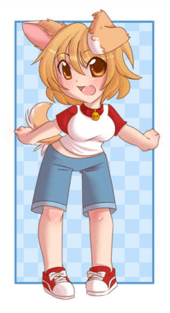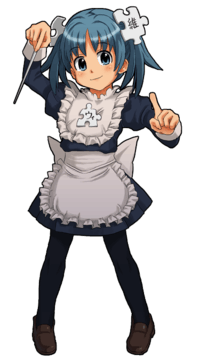Moe anthropomorphism
Moe anthropomorphism (萌え擬人化 moe gijinka) is a form of anthropomorphism where moe qualities are given to non-human beings, objects, concepts, or phenomena. In addition to moe features, moe anthropomorphisms are also characterized by their accessories, which serve to emphasize their original forms before anthropomorphosis. The characters here, usually in a kind of cosplay, are drawn to represent an inanimate object or popular consumer product. Part of the humor of this personification comes from the personality ascribed to the character (often satirical) and the sheer arbitrariness of characterizing a variety of machines, objects, and even physical places as cute.
This form of anthropomorphism is very common in otaku subcultures. With the exception of kemonomimi (which are human-like characters that have animal features), many moe anthropomorphizations started as dōjin efforts. At first many were the results of discussions on Japanese internet forums such as 2channel or Futaba Channel. The trend spread out of dōjin circles as commercial anime and manga also prominently feature characters who are personifications of inanimate objects.
Types
Animals

Kemonomimi, literally meaning "animal ears", is the concept of drawing animals as bishōjo or bishōnen, or having such characters wear animal accessories such as ears or tails. Catgirls and catboys are the most prolific in this category, although bunnygirls, foxgirls, and dog girls are also common. Kemonomimi characters typically appear human except for added animal-like qualities. The concept has some connection to furry fandom.
Computers
Although Chobits (2001) and Toy's iMac Girl (1998) came first, the meme of turning computer-related phenomena into moe subjects did not start until Shiitake-chan (しいたけちゃん), the anthropomorphization of Internet Explorer's Stop button. The idea of Shiitake-chan came in 2001 on 2channel, starting with a poster who claims he saw the Stop button as a shiitake.[2] When Microsoft released Windows 7 in Japan, they included a theme pack centered around a personification of the OS named "Nanami Madobe" with voice samples from Nana Mizuki. Microsoft used another personification involving two girls named "Yū Madobe" and "Ai Madobe" to promote Windows 8 in Japan.[3][4][5] As part of the market launch, a Facebook draw of 8 followers took place when follower count reaches 80001; and total Twitter follower count for Yū and Ai reach 8001, where winners receive Madobe Yū and Ai-themed prizes.[6]
Since the creation of the OS-tans, other software and websites have been anthropomorphized as well. For example, the free encyclopedia Wikipedia has its own "Wikipe-tan", while Mozilla applications have their own set of "Moezilla". Chinese netizens have created a "Green Dam Girl" to parody China's content-control software Green Dam Youth Escort.[7] In 2010, Taiwanese illustrator known as "shinia" on Pixiv created a personification of Microsoft Silverlight named Hikaru Aizawa, who is officially promoted by Microsoft Taiwan.[8][9] In 2013, Microsoft Singapore introduced Inori Aizawa, a mascot for Internet Explorer.
The manga and anime series Aoi Sekai no Chūshin de features characters who are personifications of computer games. Video games with characters based on them include Sonic the Hedgehog, Super Mario and Tetris. The anime series Hi sCoool! SeHa Girl features personifications of video game hardware by Sega.[10]
Law and politics
Elements of the Japanese constitution have been anthropomorphised into moe girls, such as Article 9, which prevents Japan from waging war, "is portrayed as a peace-loving girl."[11]
In 2010, users from the Breaking News board on 2channel created Hinomoto Oniko as an anthropomorphism of the commonly used Chinese ethnic slur used against Japanese, Riben guizi (日本鬼子), literally meaning "Japanese devils". The character was made by the 2channel community in response to the growing anti-Japanese sentiment amongst Chinese netizens online, and has since become an Internet meme within Japanese imageboards and forums. In Japanese, the kun'yomi reading of the kanji which make up the racial slur can be interpreted as a female personal name, and so the character is depicted as a young female wearing a traditional Japanese kimono, along with devil horns and a katana.[12]
In 2015, Internet users created "ISIS-chan", a moe anthropomorphized character of the jihadist group Islamic State of Iraq and Syria (ISIS). Images of her have been used by Anonymous to dilute the Islamic State's online propaganda.[13]
Others
Other things have also been given moe characteristics:
- Cells
- The manga Cells at Work! depicts the cells of the human body as both male and female characters.
- Charcoal
- Based on binchōtan and other types of charcoal, the anime and manga Binchō-tan uses the dajare in the Japanese word for coal (炭 tan) to create a series of cute girls.
- Countries
- As with national personifications, moe versions of various countries are present. For example, Japan is Nihon-chan,[14] Afghanistan is Afuganisu-tan — both have their own webcomics in Japan. Beyond these, however, are the countries of Hidekaz Himaruya's Hetalia: Axis Powers,[15][16] a manga depicting the countries involved in World War I and World War II using boys instead of girls, with only a few female characters mixed in.
- Diseases
- On the image sharing website 4chan, an image demonstrating a moe version of Ebola was published as a "challenge image", being that a specific phrase had to be posted after the image had been seen on the website.
- Food
- Habanero-tan, the unofficial mascot of Bōkun Habanero; and Bisuke-tan for biscuits that KFC sells in Japan. The light novel series Akikan! has soda cans that magically turn into girls. Jelly flavours have also been anthropomorphised.[17]
- Home appliances
- Erotic computer games Like Life and Monogokoro, Monomusume both feature home appliances as girls. These appliances include washing machines, alarm clocks, blackboard erasers, pillows, first aid boxes, cell phones, and even post boxes, among others. The very nature of such games, however, puts the main characters in unusual situations when the sex scene happens — such as essentially "having sex with the washing machine". Likewise, the manga 090 Eko to Issho features girls who are cell phones.
- Military hardware
- Mecha Musume are anthropomorphic personifications of military hardware, such as guns, tanks, ships, aircraft or even missiles. Popular subjects of this kind of anthropomorphism include World War II military vehicles; collectible mecha musume figures of these vehicles have been released.[18] Strike Witches, Upotte!!, and Kantai Collection are popular works that are based on moe military hardware.
- Vehicles
- Notable trains who were drawn as girls include the Fastech 360, often drawn with cat ears because of the train's emergency air braking plates. Called "Fastech-tan", this particular "train girl" has its own collectible figure, sold with permission from the East Japan Railway Company.[19]
See also
References
- ↑ Maciamo (2004). "How to Use Japanese Suffixes". Jref.com.
- ↑ ""I'm Worried that the Stop Button on IE Looks Like a Shiitake" on a 2ch archive" (in Japanese). Retrieved 2007-03-06.
- ↑ 窓辺ファミリー全員集結!! DSP版限定ウィンドウズ8.1が10月4日予約開始【追記あり】
- ↑ DSP版Windows 8.1の予約受付け開始、限定版は一部でもう完売 - 限定版は3種類
- ↑ 「Windows 8.1 発売記念パック 窓辺ファミリーバージョン」の予約が瞬殺! マウス付きも数少なめ
- ↑ 窓辺ファミリーの特典付きDSP版 Windows 8.1 Proが限定発売に ~DSP版Windows 7は今後も当面併売
- ↑ "China clarifies web filter plans". BBC News. 2009-06-18. Retrieved 2009-06-20.
- ↑ "Microsoft - Silverlight 第二彈 進化再生" (in Chinese). Microsoft. Retrieved March 14, 2012.
- ↑ "ねとらぼ:台湾MSの萌えるSilverlight「藍澤光」が日本上陸 pixivで公認イラストイベント" (in Japanese). ITmedia. January 25, 2011. Retrieved March 14, 2012.
- ↑ "Sega Hard Girls CG TV Anime's High School Story, Staff, Date Unveiled". Anime News Network. June 10, 2014. Retrieved August 29, 2014.
- ↑ "Constitution Girls Book Turns Law Into Moe Girls". Anime News Network. June 29, 2011. Retrieved June 30, 2011.
- ↑ 萌系日本鬼子 反攻中國 (in Chinese). The Liberty Times. November 2, 2010. Retrieved November 5, 2010.
- ↑ "Anonymous targets IS sympathisers on Twitter". BBC. July 21, 2015. Retrieved July 21, 2015.
- ↑ "Nihon-chan a la carte" (in Japanese). Retrieved 2008-04-23.
- ↑ Hidekaz Himaruya. "Axis Powers Hetalia". www.geocities.jp/himaruya (in Japanese). Geocities. Retrieved 2008-05-30.
- ↑ "ejcjs - Moe and the Potential of Fantasy in Post-Millennial Japan". Japanesestudies.org.uk. Retrieved 2012-08-20.
- ↑ "Rie Kugimiya, Rina Satou, 3 Others Voice Moe Jelly". Anime News Network. July 11, 2011. Retrieved July 13, 2011.
- ↑ "Mecha Musume Figumate Figure Gashapon Set of 5 Konami". Amazon.com. Retrieved August 19, 2011.
- ↑ "Train Anthropomorphism SuperExpress Train Girls "Fasutekku 360S"" (in Japanese). Archived from the original on 2007-05-05. Retrieved 2007-03-06.
Further reading
- Gijinka tan Hakusho (擬人化たん白書, lit. Anthropomorphism-tan Files). Tokyo, Japan: Aspect, 2006. ISBN 4-7572-1262-3.
External links
| Wikimedia Commons has media related to Moe anthropomorphism. |
